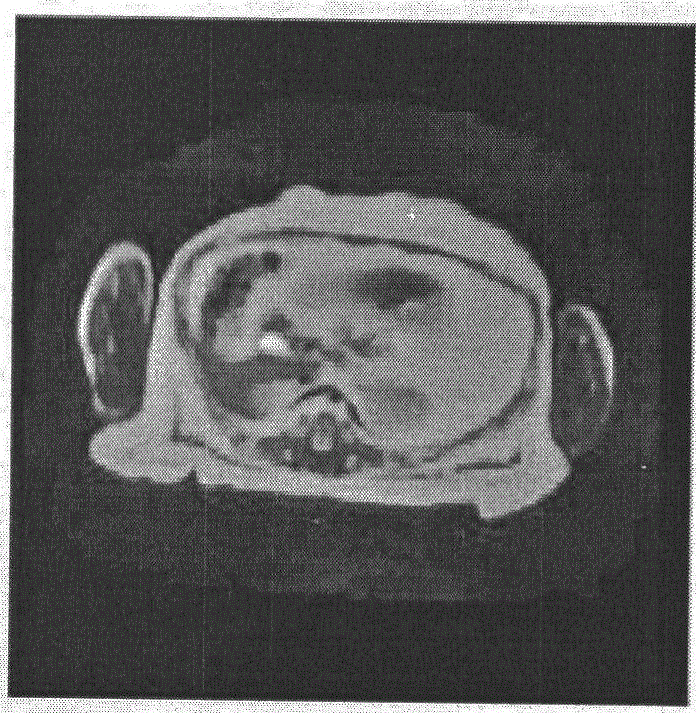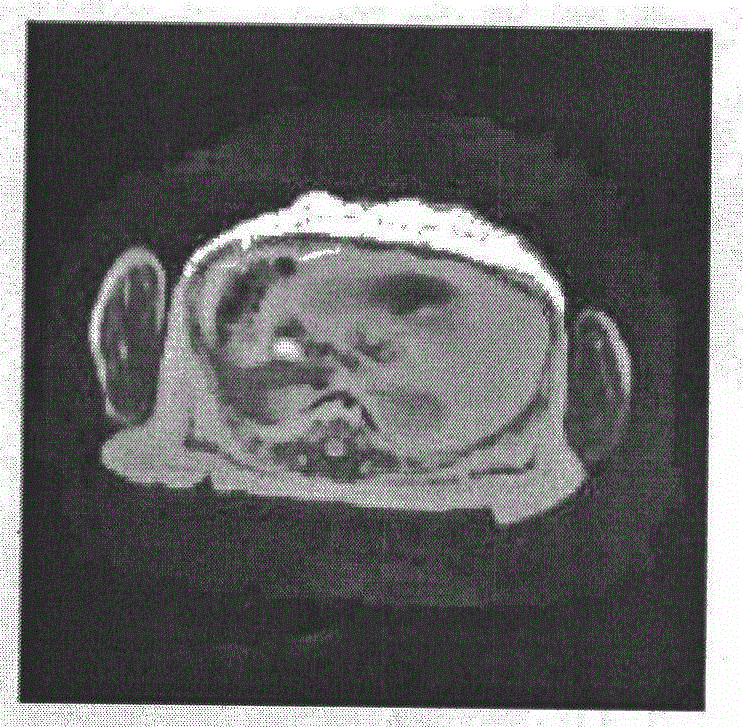Quantitative analysis method suitable for abdominal subcutaneous fat of primate laboratory animal
A subcutaneous fat, experimental animal technology, applied in image analysis, image data processing, instruments, etc., can solve problems such as inability to obtain quantitative results, blurred MRI images, and indistinct distinctions.
- Summary
- Abstract
- Description
- Claims
- Application Information
AI Technical Summary
Problems solved by technology
Method used
Image
Examples
Embodiment 1
[0030] A method for quantitative analysis of abdominal subcutaneous fat suitable for primate experimental animals, comprising the steps of:
[0031] (1) The primate experimental animals are placed in a supine position. When the animals are placed, the center of the eyebrows, the tip of the nose, the middle gap of the incisors, the midpoint of the line connecting the nipples, and the navel of the animal are connected into a line, and the abdomen of the animal is scanned by MRI. After setting, the Dicom format T2 phase image and FS-FSE-T2WI lipid suppression image;
[0032] (2) Use MATLAB software to adjust the contrast enhancement of the above original image, use standardized histogram operation to equalize the image histogram, and use 6*6 median filter to denoise the median filter; use 9*9 Gaussian filter for Gaussian filter Filter denoising; the mean value filter is adjusted by using 9*9 mean value filter denoising image filtering, and the pixel value is stretched to 0-1;
...
Embodiment 2
[0039] A method for quantitative analysis of abdominal subcutaneous fat suitable for primate experimental animals, comprising the steps of:
[0040] (1) The primate experimental animals are placed in a supine position. When the animals are placed, the center of the eyebrows, the tip of the nose, the middle gap of the incisors, the midpoint of the line connecting the nipples, and the navel of the animal are connected into a line, and the abdomen of the animal is scanned by MRI. After setting, the Dicom format T2 phase image and FS-FSE-T2WI lipid suppression image;
[0041] (2) Use MATLAB software to adjust the contrast enhancement of the above original image, use standardized histogram operation to equalize the image histogram, and use 6*6 median filter to denoise the median filter; use 9*9 Gaussian filter for Gaussian filter Filter denoising; the mean value filter is adjusted by using 9*9 mean value filter denoising image filtering, and the pixel value is stretched to 0-1;
...
Embodiment 3
[0048] A method for quantitative analysis of abdominal subcutaneous fat suitable for primate experimental animals, comprising the steps of:
[0049] (1) The primate experimental animals are placed in a supine position. When the animals are placed, the center of the eyebrows, the tip of the nose, the middle gap of the incisors, the midpoint of the line connecting the nipples, and the navel of the animal are connected into a line, and the abdomen of the animal is scanned by MRI. After setting, the Dicom format T2 phase image and FS-FSE-T2WI lipid suppression image;
[0050] (2) Use MATLAB software to adjust the contrast enhancement of the above original image, use standardized histogram operation to equalize the image histogram, and use 6*6 median filter to denoise the median filter; use 9*9 Gaussian filter for Gaussian filter Filter denoising; the mean value filter is adjusted by using 9*9 mean value filter denoising image filtering, and the pixel value is stretched to 0-1;
...
PUM
 Login to View More
Login to View More Abstract
Description
Claims
Application Information
 Login to View More
Login to View More - R&D Engineer
- R&D Manager
- IP Professional
- Industry Leading Data Capabilities
- Powerful AI technology
- Patent DNA Extraction
Browse by: Latest US Patents, China's latest patents, Technical Efficacy Thesaurus, Application Domain, Technology Topic, Popular Technical Reports.
© 2024 PatSnap. All rights reserved.Legal|Privacy policy|Modern Slavery Act Transparency Statement|Sitemap|About US| Contact US: help@patsnap.com










